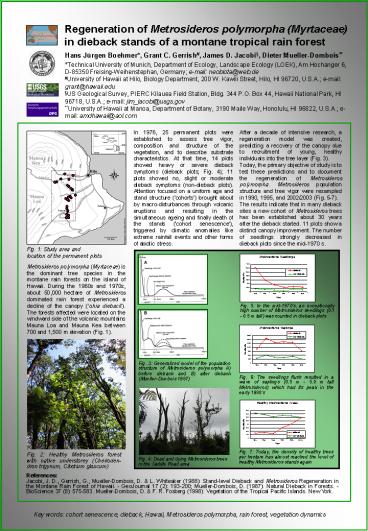Folie 1 - PowerPoint PPT Presentation
Title: Folie 1
1
Regeneration of Metrosideros polymorpha
(Myrtaceae) in dieback stands of a montane
tropical rain forest
Hans Jürgen Boehmer, Grant C. Gerrish, James D.
Jacobi, Dieter Mueller-Dombois Technical
University of Munich, Department of Ecology,
Landscape Ecology (LOEK), Am Hochanger 6, D-85350
Freising-Weihenstephan, Germany e-mail
neobiota_at_web.de University of Hawaii at Hilo,
Biology Department, 200 W. Kawili Street, Hilo,
HI 96720, U.S.A. e-mail grant_at_hawaii.edu US
Geological Survey, PIERC Kilauea Field Station,
Bldg. 344 P.O. Box 44, Hawaii National Park, HI
96718, U.S.A. e-mail jim_jacobi_at_usgs.gov Unive
rsity of Hawaii at Manoa, Department of Botany,
3190 Maile Way, Honolulu, HI 96822, U.S.A.
e-mail amdhawaii_at_aol.com
After a decade of intensive research, a
regeneration model was created, predicting a
recovery of the canopy due to recruitment of
young, healthy individuals into the tree layer
(Fig. 3). Today, the primary objective of study
is to test these predictions and to document the
regeneration of Metrosideros polymorpha.
Metrosideros population structure and tree vigor
were resampled in 1990, 1995, and 2002/2003 (Fig.
5-7). The results indicate that in many dieback
sites a new cohort of Metrosideros trees has been
established about 30 years after the dieback
started. 11 plots show a distinct canopy
improvement. The number of seedlings strongly
decreased in dieback plots since the mid-1970s.
In 1976, 25 permanent plots were established to
assess tree vigor, composition and structure of
the vegetation, and to describe substrate
characteristics. At that time, 14 plots showed
heavy or severe dieback symptoms (dieback plots
Fig. 4) 11 plots showed no, slight or moderate
dieback symptoms (non-dieback plots). Attention
focused on a uniform age and stand structure
('cohorts') brought about by macro-disturbances
through volcanic eruptions and resulting in the
simultaneous ageing and finally death of the
stands ('cohort senescence'), triggered by
climatic anomalies like extreme rainfall events
and other forms of abiotic stress.
Fig. 1 Study area and location of the permanent
plots
Metrosideros polymorpha (Myrtaceae) is the
dominant tree species in the montane rain forests
on the island of Hawaii. During the 1960s and
1970s, about 50,000 hectare of Metrosideros
dominated rain forest experienced a decline of
the canopy ('ohia dieback). The forests affected
were located on the windward side of the volcanic
mountains Mauna Loa and Mauna Kea between 700 and
1,500 m elevation (Fig. 1).
Fig. 5 In the mid-1970s, an exceptionally high
number of Metrosideros seedlings (0.1 - 0.5 m
tall) was counted in dieback plots
Fig. 3 Generalized model of the population
structure of Metrosideros polymorpha A) before
dieback and B) after dieback (Mueller-Dombois
1987)
Fig. 6 The seedlings flush resulted in a wave of
saplings (0.5 m - 5.0 m tall Metrosideros) which
had its peak in the early 1980s
Fig. 7 Today, the density of healthy trees per
hectare has almost reached the level of healthy
Metrosideros stands again
Fig. 2 Healthy Metrosideros forest with native
understorey (Cheiroden-dron trigynum, Cibotium
glaucum)
Fig. 4 Dead and dying Metrosideros trees in the
Saddle Road area
References Jacobi, J. D., Gerrish, G.,
Mueller-Dombois, D. L. Whiteaker (1988)
Stand-level Dieback and Metrosideros Regeneration
in the Montane Rain Forest of Hawaii. -
GeoJournal 17 (2) 193-200 Mueller-Dombois, D.
(1987) Natural Dieback in Forests. - BioScience
37 (8) 575-583. Mueller-Dombois, D. F. R.
Fosberg (1998) Vegetation of the Tropical
Pacific Islands. New York.
Key words cohort senescence, dieback, Hawaii,
Metrosideros polymorpha, rain forest, vegetation
dynamics































